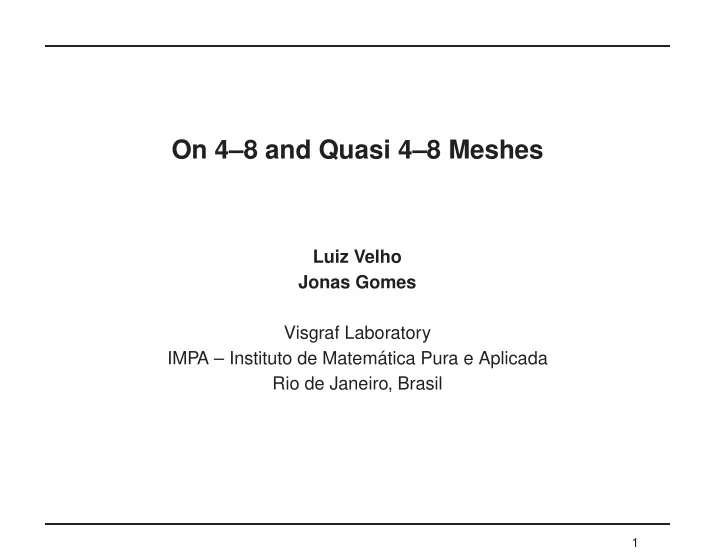

On 4–8 and Quasi 4–8 Meshes Luiz Velho Jonas Gomes Visgraf Laboratory IMPA – Instituto de Matem´ atica Pura e Aplicada Rio de Janeiro, Brasil 1
Outline � Background on 4-8 Meshes � Hierarchical Quasi 4-8 Meshes � Representation and Operations � Construction Methods � Recent Developments 2
Background � Origins of Classical 4–8 Meshes – Leaves Tilings – 4–direction Meshes – Quincunx Lattices � Generalizations of 4–8 Meshes 3
2 Uniform Partitions of R � Leaves Tilings 4 3 2 [4 ] [6 ] [4 : 8 ] * Symmetry: Crystallographic Groups 4
Four Direction Meshes ( e + ) � Generated by the vectors � ; e ; e e ; e e 1 2 1 2 1 2 5
Quincunx Lattices ! 1 1 = f M x ; 2 � g , where M is the quincunx matrix = Q x Z Z M � 1 � 1 � Two Interleaved Quincunx Lattices 6
Four Direction Box Splines ! 1 0 1 1 1 basis function generated by the convolution set C � 0 1 1 � 1 * Defined on Quadrilaterals 7
Generalization of 4–8 Meshes � Regular 4–8 Meshes – 4–8 Topology ( deg ( v ) = 4 ; 8 ) � Semi-Regular 4–8 Meshes – Isolated Extraordinary Vertices ( deg ( v ) 6 = 4 ; 8 ) * Most of the properties of 4–8 Meshes 8
Hierarchical 4–8 Meshes � Construction Methods – Direct Refinement – Red-Black Refinement � Representation – Multiresolution Representation – Variable Resolution Representation 9
Direct Refinement � Quaternary Subdivision � Template 10
Red-Black Refinement � Recursive Binary Subdivision � Template 11
Hierarchy of Right Triangles � Binary Tree Representation * Regular Case (Terrain) 12
Variable Resolution Multi-Triangulation � Dependency Graph (DAG) * Semi-Regular Case 13
Query Operations � Cut in the DAG � Definition: – Threshold Function – Focus Set 14
Mesh Extraction � Adapted Meshes – Geometry Approximation – View-Dependent – Etc. * Consistency by Construction 15
Construction Methods � Local Modifications – Refinement (Edge Bisection) # " simplification refinement – Simplification (Half Edge Collapse) 16
New Developments � Refinement Methods – Topology-Based (Generalized 4 direction Box Splines) – Geometry-Sensitive (Quasi 4–8 Subdivision Surfaces) – Adaptive (Tesselation of Parametric and Implicit Surfaces) � Simplification Methods – Topology Preserving (2-Manifold Triangle Meshes) 17
Four Direction Box Splines � Interleaved Edge Subdivision 18
Quasi 4–8 Subdivision Surfaces � Longest Edge Bisection 19
Adaptive Surface Tesselation � Multiresolution Edge Sampling parametric surface implicit surface 20
Surface Simplification � Half-Edge Collapse and Edge Swap 21
Future Work � Hierarchical Parametrizations � Multiresolution Decomposition � Space-Filling Hamiltonian Paths � Integrated Framework 22
Recommend
More recommend